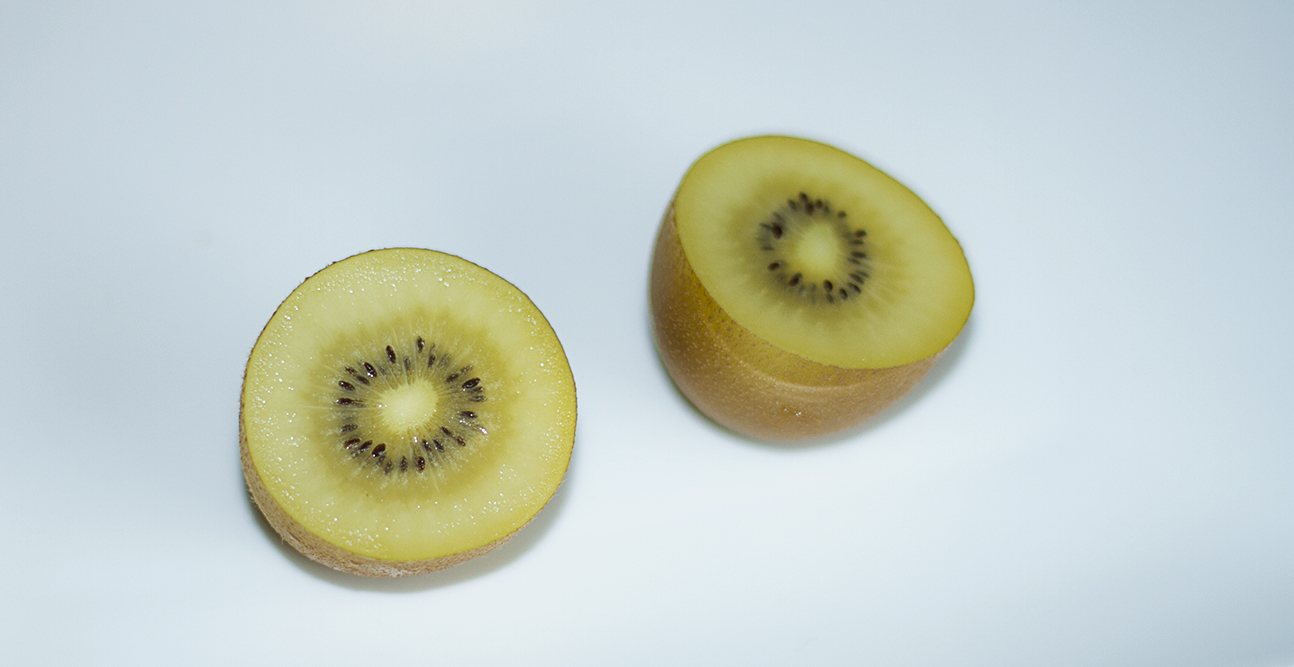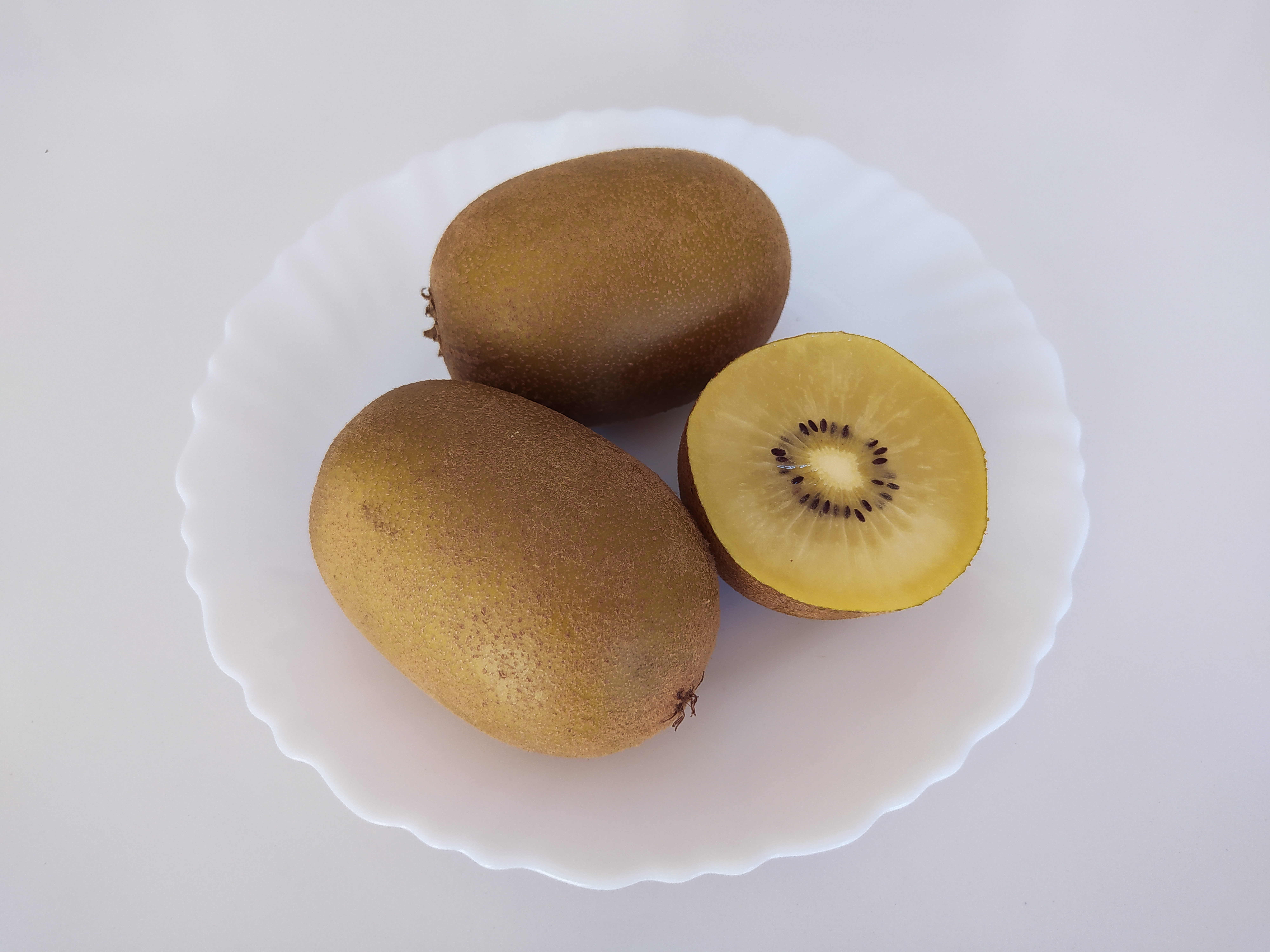Actinidia chinensis on:
[Wikipedia]
[Google]
[Amazon]
 ''Actinidia chinensis'' (Planch.), known commercially as the golden kiwifruit, is a fruiting vine, native to China. It is one of some 40 related species of the
''Actinidia chinensis'' (Planch.), known commercially as the golden kiwifruit, is a fruiting vine, native to China. It is one of some 40 related species of the
 ''Actinidia chinensis'' has a smooth, bronze skin, with a beak shape at the stem attachment. Flesh colour varies from bright green to a clear, intense yellow. This species is sweeter and more aromatic in flavour compared to ''A. deliciosa'', similar to some subtropical fruits. One of the most attractive varieties has a red 'iris' around the centre of the fruit and yellow flesh outside. The yellow fruit obtains a higher market price and, being less hairy than the fuzzy kiwifruit, is more palatable for consumption without peeling. A commercially viable variety of this red-ringed kiwifruit, patented as ''EnzaRed'', is a cultivar of the Chinese hong yang variety.
''Actinidia chinensis'' has a smooth, bronze skin, with a beak shape at the stem attachment. Flesh colour varies from bright green to a clear, intense yellow. This species is sweeter and more aromatic in flavour compared to ''A. deliciosa'', similar to some subtropical fruits. One of the most attractive varieties has a red 'iris' around the centre of the fruit and yellow flesh outside. The yellow fruit obtains a higher market price and, being less hairy than the fuzzy kiwifruit, is more palatable for consumption without peeling. A commercially viable variety of this red-ringed kiwifruit, patented as ''EnzaRed'', is a cultivar of the Chinese hong yang variety.
 'Hort16A' is a golden kiwifruit cultivar marketed worldwide, first as ''Zespri Gold'', then as ''SunGold''. This cultivar suffered significant losses in New Zealand from late 2010 to 2013 due to the PSA bacterium. A new cultivar of golden kiwifruit, 'Zesy002', was found to be more disease-resistant and most growers changed to this cultivar, with its worldwide demand continuing into 2019.
'Hort16A' is a golden kiwifruit cultivar marketed worldwide, first as ''Zespri Gold'', then as ''SunGold''. This cultivar suffered significant losses in New Zealand from late 2010 to 2013 due to the PSA bacterium. A new cultivar of golden kiwifruit, 'Zesy002', was found to be more disease-resistant and most growers changed to this cultivar, with its worldwide demand continuing into 2019.
 ''Actinidia chinensis'' (Planch.), known commercially as the golden kiwifruit, is a fruiting vine, native to China. It is one of some 40 related species of the
''Actinidia chinensis'' (Planch.), known commercially as the golden kiwifruit, is a fruiting vine, native to China. It is one of some 40 related species of the genus
Genus ( plural genera ) is a taxonomic rank used in the biological classification of living and fossil organisms as well as viruses. In the hierarchy of biological classification, genus comes above species and below family. In binomial nom ...
'' Actinidia'', and closely related to '' Actinidia deliciosa'', which is the source of the most common commercial kiwifruit
Kiwifruit (often shortened to kiwi in North American, British and continental European English) or Chinese gooseberry is the edible berry of several species of woody vines in the genus '' Actinidia''. The most common cultivar group of kiwi ...
. Fruit colour may vary from green to lime green
Lime commonly refers to:
* Lime (fruit), a green citrus fruit
* Lime (material), inorganic materials containing calcium, usually calcium oxide or calcium hydroxide
* Lime (color), a color between yellow and green
Lime may also refer to:
Botany
...
or gold, depending on breeding
Breeding is sexual reproduction that produces offspring, usually animals or plants. It can only occur between a male and a female animal or plant.
Breeding may refer to:
* Animal husbandry, through selected specimens such as dogs, horses, and ra ...
.
Description
 ''Actinidia chinensis'' has a smooth, bronze skin, with a beak shape at the stem attachment. Flesh colour varies from bright green to a clear, intense yellow. This species is sweeter and more aromatic in flavour compared to ''A. deliciosa'', similar to some subtropical fruits. One of the most attractive varieties has a red 'iris' around the centre of the fruit and yellow flesh outside. The yellow fruit obtains a higher market price and, being less hairy than the fuzzy kiwifruit, is more palatable for consumption without peeling. A commercially viable variety of this red-ringed kiwifruit, patented as ''EnzaRed'', is a cultivar of the Chinese hong yang variety.
''Actinidia chinensis'' has a smooth, bronze skin, with a beak shape at the stem attachment. Flesh colour varies from bright green to a clear, intense yellow. This species is sweeter and more aromatic in flavour compared to ''A. deliciosa'', similar to some subtropical fruits. One of the most attractive varieties has a red 'iris' around the centre of the fruit and yellow flesh outside. The yellow fruit obtains a higher market price and, being less hairy than the fuzzy kiwifruit, is more palatable for consumption without peeling. A commercially viable variety of this red-ringed kiwifruit, patented as ''EnzaRed'', is a cultivar of the Chinese hong yang variety.
 'Hort16A' is a golden kiwifruit cultivar marketed worldwide, first as ''Zespri Gold'', then as ''SunGold''. This cultivar suffered significant losses in New Zealand from late 2010 to 2013 due to the PSA bacterium. A new cultivar of golden kiwifruit, 'Zesy002', was found to be more disease-resistant and most growers changed to this cultivar, with its worldwide demand continuing into 2019.
'Hort16A' is a golden kiwifruit cultivar marketed worldwide, first as ''Zespri Gold'', then as ''SunGold''. This cultivar suffered significant losses in New Zealand from late 2010 to 2013 due to the PSA bacterium. A new cultivar of golden kiwifruit, 'Zesy002', was found to be more disease-resistant and most growers changed to this cultivar, with its worldwide demand continuing into 2019.
Habitat
In its native habitat ''Actinidia chinensis'' grows in thickets, thick (oak
An oak is a tree or shrub in the genus ''Quercus'' (; Latin "oak tree") of the beech family, Fagaceae. There are approximately 500 extant species of oaks. The common name "oak" also appears in the names of species in related genera, notably ''L ...
) forests (e.g. ''Quercus aquifolioides'', ''Quercus oxyodon'', ''Quercus lamellosa
''Quercus lamellosa'' (syn. ''Cyclobalanopsis lamellosa'') is a species of oak native to the Himalaya and adjoining mountains from Tibet and Nepal east as far as Guangxi and northern Thailand, growing at altitudes of 1300–2500 m. The Lepcha ...
''), and light secondary forests and bushland. ''A. chinensis'' prefers slopes and likes also to grow in ravine
A ravine is a landform that is narrower than a canyon and is often the product of streambank erosion.microclimate
A microclimate (or micro-climate) is a local set of atmospheric conditions that differ from those in the surrounding areas, often with a slight difference but sometimes with a substantial one. The term may refer to areas as small as a few squ ...
. In Western gardens it may range in all directions, making it unsuitable for all but the largest spaces unless pruned back hard at the end of every growing season.
Origin and cultivation
The origin of ''Actinidia chinensis'' is fromHubei
Hubei (; ; alternately Hupeh) is a landlocked province of the People's Republic of China, and is part of the Central China region. The name of the province means "north of the lake", referring to its position north of Dongting Lake. The ...
or Sichuan
Sichuan (; zh, c=, labels=no, ; zh, p=Sìchuān; alternatively romanized as Szechuan or Szechwan; formerly also referred to as "West China" or "Western China" by Protestant missions) is a province in Southwest China occupying most of the ...
, China exported to New Zealand in 1904. In China, ''Actinidia chinensis'' is dispersed in the entire southeast of the country. It was first grown commercially in New Zealand, where it has been bred commercially as the variety, '' Actinidia deliciosa''.
Herbarium specimens, but not plants, were forwarded to the Royal Horticultural Society by the British plant hunter Robert Fortune
Robert Fortune (16 September 1812 – 13 April 1880) was a Scottish botanist, plant hunter and traveller, best known for introducing around 250 new ornamental plants, mainly from China, but also Japan, into the gardens of Britain, Australia, an ...
, from which Jules Émile Planchon
Jules Émile Planchon (21 March 1823 – 1 April 1888) was a French botanist born in Ganges, Hérault.
Biography
After receiving his Doctorate of Science at the University of Montpellier in 1844, he worked for a while at the Royal Botanical G ...
named the new genus in the ''London Journal of Botany'', 1847. Charles Maries
Charles Maries (18 December 1851 – 11 October 1902) was an English botanist and plant collector who was sent by James Veitch & Sons of Chelsea, London to search for new hardy plants in Japan, China and Taiwan between 1877 and 1879; there he dis ...
, collecting for Messrs Veitch noted it in Japan, but the introduction to Western horticulture was from E.H. Wilson, who sent seeds collected in Hupeh
Hubei (; ; alternately Hupeh) is a landlocked province of the People's Republic of China, and is part of the Central China region. The name of the province means "north of the lake", referring to its position north of Dongting Lake. The prov ...
to Veitch in 1900.Alice M. Coats, ''Garden Shrubs and Their History'' (1964) 1992, ''s.v.'' "Actinidia".
Uses
The fruits – about the size of achicken egg
Humans and human ancestors have scavenged and eaten animal eggs for millions of years. Humans in Southeast Asia had domesticated chickens and harvested their eggs for food by 1,500 BCE. The most widely consumed eggs are those of fowl, especia ...
– are edible, providing a rich source of vitamin C
Vitamin C (also known as ascorbic acid and ascorbate) is a water-soluble vitamin found in citrus and other fruits and vegetables, also sold as a dietary supplement and as a topical 'serum' ingredient to treat melasma (dark pigment spots) ...
and dietary fiber.
References
{{Taxonbar, from=Q163522 chinensis Flora of China Fruits originating in East Asia Plants used in traditional Chinese medicine Garden plants of Asia Dioecious plants